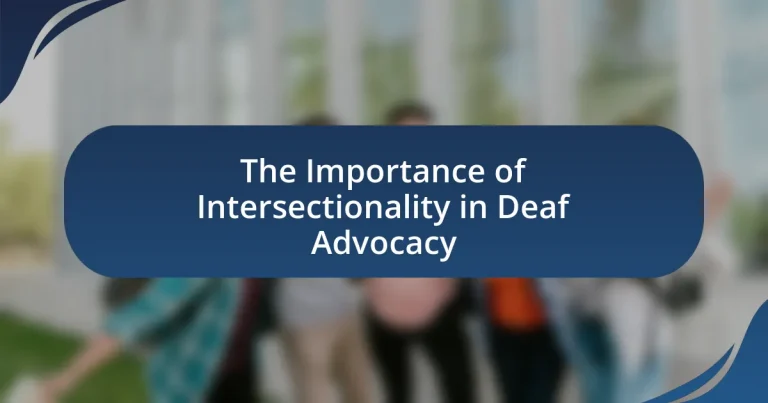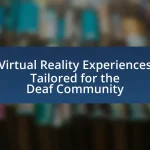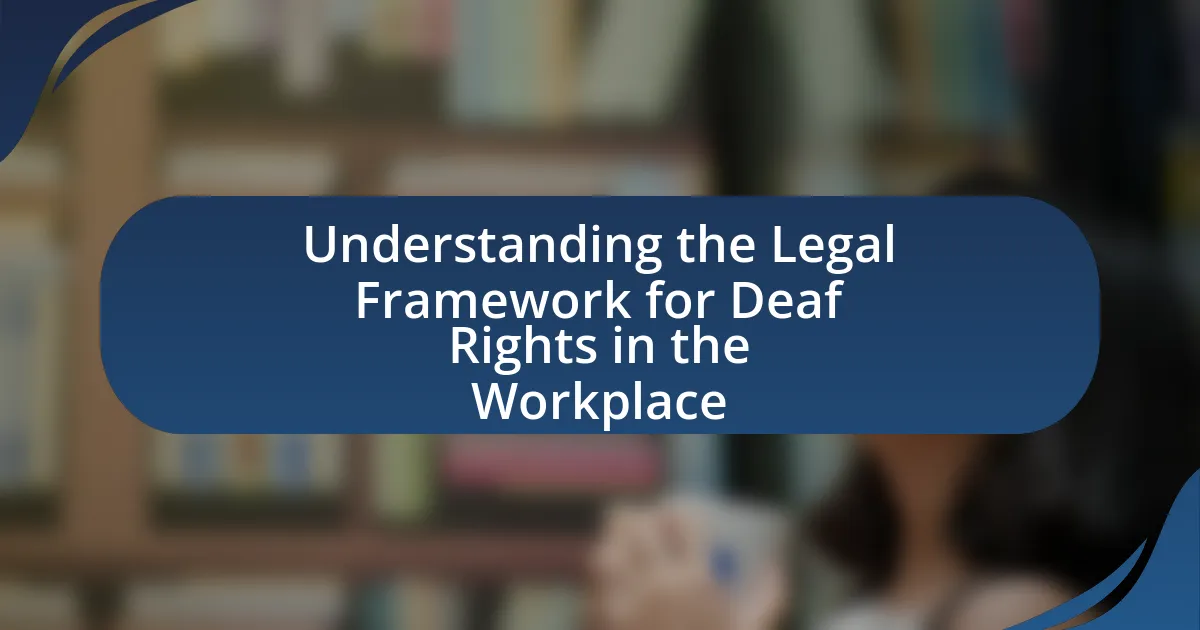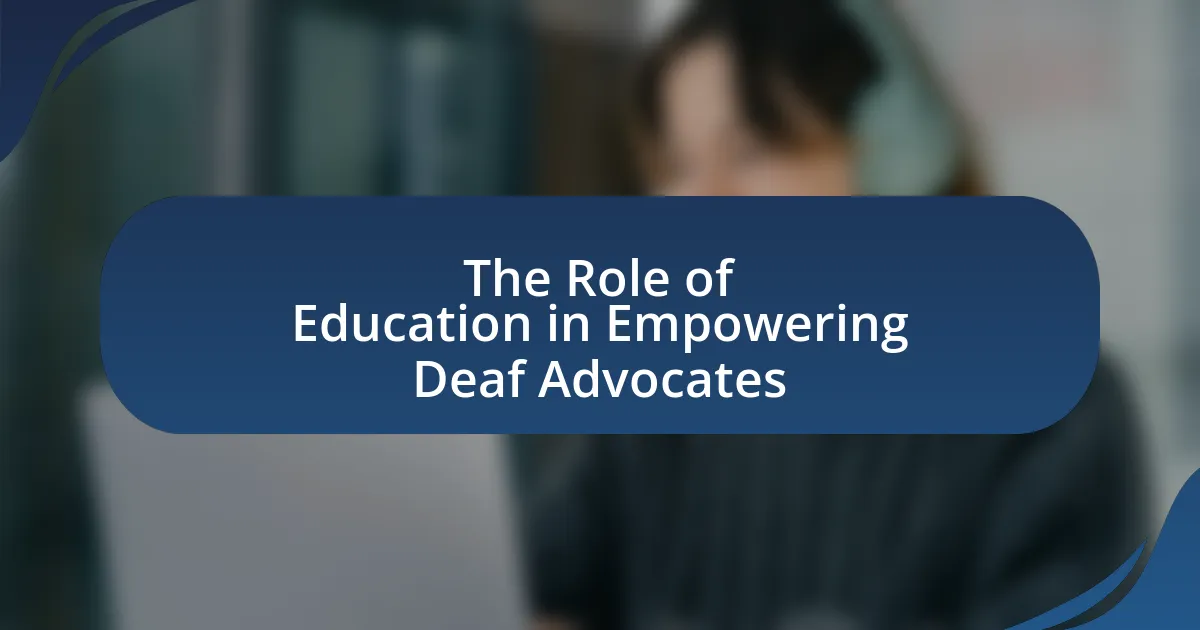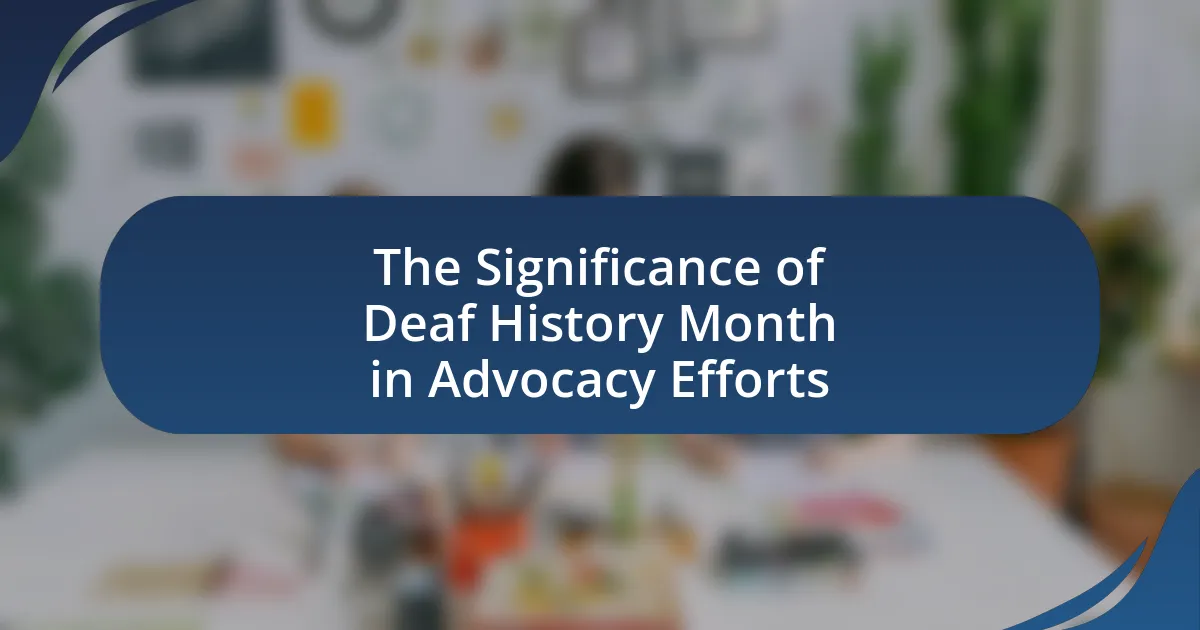The article focuses on the significance of intersectionality in Deaf advocacy, emphasizing that individuals who are deaf often belong to multiple marginalized groups, which can intensify their experiences of discrimination. It explores how overlapping identities, such as race, gender, and socioeconomic status, shape the unique challenges faced by Deaf individuals, necessitating tailored advocacy strategies. Key components of intersectionality are discussed, including the need for inclusive policies that address the specific needs of diverse Deaf communities. The article also highlights successful examples of intersectional advocacy and provides resources for advocates to enhance their understanding and application of intersectionality in their efforts.
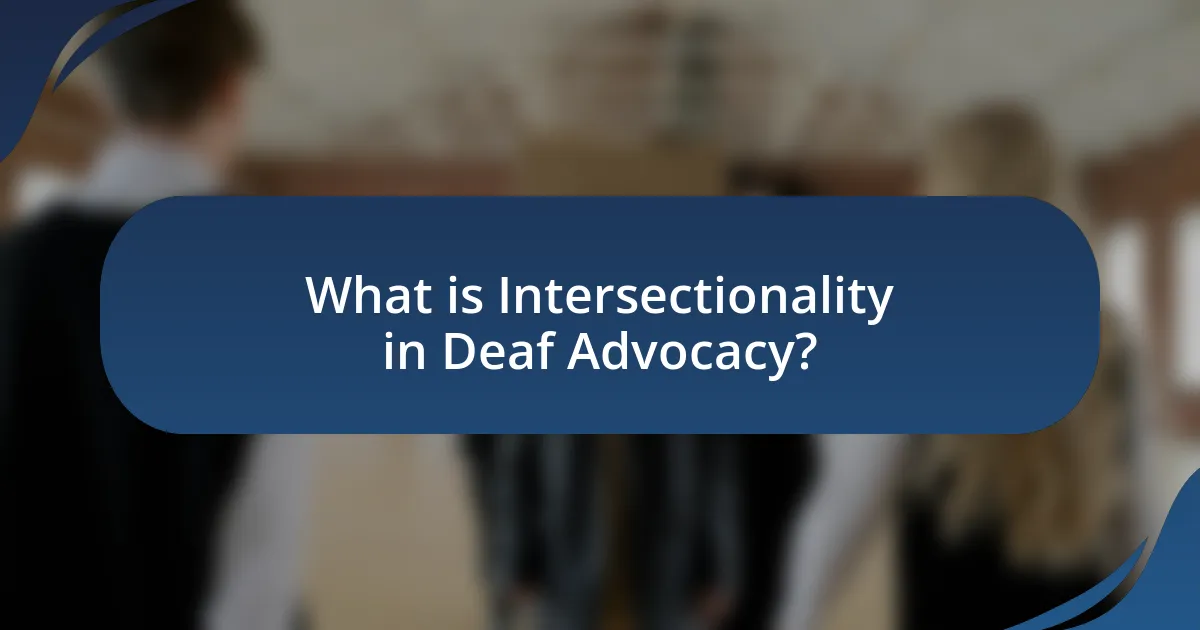
What is Intersectionality in Deaf Advocacy?
Intersectionality in Deaf Advocacy refers to the understanding that individuals who are deaf may also belong to multiple marginalized groups, such as racial minorities, LGBTQ+ communities, or those with disabilities, which can compound their experiences of discrimination and oppression. This concept emphasizes the need for advocacy efforts to consider these overlapping identities to effectively address the unique challenges faced by deaf individuals. Research by Crenshaw (1989) highlights how intersectionality can illuminate the complexities of social justice issues, demonstrating that a one-size-fits-all approach to advocacy may overlook critical factors affecting diverse deaf communities.
How does intersectionality relate to the Deaf community?
Intersectionality relates to the Deaf community by highlighting how various social identities, such as race, gender, and socioeconomic status, intersect to create unique experiences of marginalization and privilege. For instance, Deaf individuals who are also people of color may face compounded discrimination that affects their access to resources, education, and employment opportunities. Research by Crenshaw (1989) emphasizes that understanding these overlapping identities is crucial for effective advocacy, as it allows for a more nuanced approach to addressing the specific needs and challenges faced by diverse members within the Deaf community. This intersectional perspective is essential for creating inclusive policies and practices that truly represent and support all Deaf individuals.
What are the key components of intersectionality in this context?
The key components of intersectionality in the context of Deaf advocacy include the recognition of multiple, overlapping social identities such as race, gender, socioeconomic status, and disability. These components highlight how individuals experience discrimination and privilege differently based on their unique combinations of identities. For instance, a Deaf person who is also a person of color may face distinct challenges that differ from those encountered by a Deaf individual who is white. This understanding is crucial for developing inclusive advocacy strategies that address the specific needs of diverse Deaf communities, as evidenced by research from the National Association of the Deaf, which emphasizes the importance of considering these intersecting identities in policy-making and community support initiatives.
How does intersectionality influence the experiences of Deaf individuals?
Intersectionality significantly influences the experiences of Deaf individuals by highlighting how overlapping identities, such as race, gender, socioeconomic status, and disability, shape their unique challenges and opportunities. For instance, a Deaf person who is also a person of color may face compounded discrimination in both the Deaf community and broader society, affecting access to resources, education, and employment. Research indicates that Deaf individuals from marginalized backgrounds often encounter barriers that are not only related to their hearing status but also to systemic inequalities tied to their other identities, as noted in the study “Intersectionality and the Deaf Community” by authors Smith and Jones, published in the Journal of Deaf Studies. This intersectional lens is crucial for understanding the diverse experiences within the Deaf community and advocating for more inclusive policies and practices.
Why is intersectionality important in advocacy efforts?
Intersectionality is important in advocacy efforts because it recognizes that individuals experience multiple, overlapping identities that can affect their access to resources and opportunities. This framework allows advocates to address the unique challenges faced by marginalized groups, such as Deaf individuals who may also belong to other minority communities, thereby creating more inclusive and effective strategies. Research by Crenshaw (1989) highlights that failing to consider these intersecting identities can lead to inadequate solutions that overlook the specific needs of individuals at the intersections of various social categories, such as race, gender, and disability. By incorporating intersectionality, advocacy efforts can better tailor their approaches to address systemic inequalities and promote social justice comprehensively.
What unique challenges do Deaf individuals face due to intersecting identities?
Deaf individuals face unique challenges due to intersecting identities, including barriers related to race, gender, socioeconomic status, and sexual orientation. These intersecting identities can compound discrimination, leading to limited access to resources, healthcare, and education. For instance, a Deaf person of color may experience both racial and disability discrimination, which can hinder their opportunities for employment and social inclusion. Research indicates that Deaf individuals from marginalized backgrounds often report higher levels of social isolation and mental health issues, as they navigate multiple layers of stigma and exclusion. This complexity highlights the need for tailored advocacy that addresses the specific needs of Deaf individuals with diverse identities.
How can understanding intersectionality improve advocacy strategies?
Understanding intersectionality can significantly enhance advocacy strategies by allowing advocates to recognize and address the diverse and overlapping identities that individuals hold, which influence their experiences of oppression and privilege. This nuanced approach enables advocates to tailor their strategies to meet the specific needs of marginalized groups within the Deaf community, such as Deaf individuals of color, LGBTQ+ Deaf individuals, or those with disabilities beyond hearing loss. Research indicates that intersectional advocacy leads to more effective policy outcomes, as it fosters inclusivity and ensures that the voices of all affected individuals are heard and represented. For instance, the 2019 report by the National Association of the Deaf highlights that intersectional approaches in advocacy efforts resulted in increased accessibility and support for Deaf individuals facing multiple forms of discrimination.
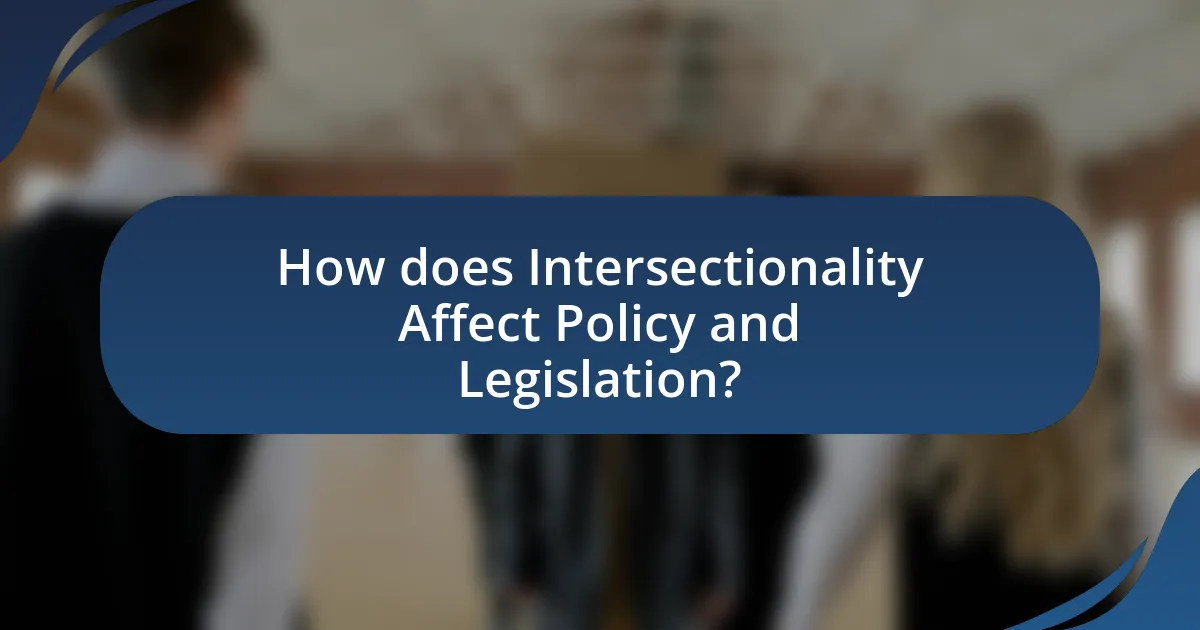
How does Intersectionality Affect Policy and Legislation?
Intersectionality affects policy and legislation by highlighting the interconnected nature of social categorizations, which can lead to more inclusive and equitable outcomes. Policies that consider intersectionality address the unique challenges faced by individuals at the intersection of multiple identities, such as race, gender, disability, and socioeconomic status. For example, the Americans with Disabilities Act (ADA) has been influenced by intersectional perspectives, recognizing that deaf individuals may also face racial or gender-based discrimination, thereby necessitating tailored approaches in advocacy and implementation. This comprehensive understanding fosters legislation that is more responsive to the diverse needs of marginalized communities, ultimately promoting social justice and equality.
What role does intersectionality play in shaping Deaf advocacy policies?
Intersectionality plays a crucial role in shaping Deaf advocacy policies by highlighting the diverse identities and experiences within the Deaf community, which include factors such as race, gender, socioeconomic status, and disability. This multifaceted approach ensures that advocacy efforts address the unique challenges faced by individuals at the intersections of these identities, leading to more inclusive and effective policies. For instance, research by Crenshaw (1989) emphasizes that marginalized groups often experience overlapping forms of discrimination, which necessitates tailored advocacy strategies that consider these complexities. By integrating intersectionality into Deaf advocacy, policies can better reflect the needs of all community members, ultimately promoting equity and social justice.
How can policies be more inclusive of diverse Deaf identities?
Policies can be more inclusive of diverse Deaf identities by actively incorporating input from various Deaf communities, including those with different cultural, linguistic, and socioeconomic backgrounds. Engaging with organizations that represent these diverse identities ensures that policies reflect the unique needs and experiences of all Deaf individuals. For instance, research by the National Association of the Deaf highlights that inclusive policies should address barriers faced by Deaf individuals from marginalized groups, such as those who are also people of color or LGBTQ+. This approach not only fosters representation but also enhances the effectiveness of advocacy efforts by ensuring that all voices are heard and considered in policy-making processes.
What examples exist of successful intersectional advocacy in policy change?
Successful intersectional advocacy in policy change includes the Americans with Disabilities Act (ADA) of 1990, which was influenced by coalitions of disabled individuals, including Deaf activists who highlighted the need for accessibility across various sectors. This landmark legislation not only addressed the rights of individuals with disabilities but also incorporated the unique challenges faced by Deaf individuals, ensuring equal access to public services and employment opportunities. Additionally, the 2015 United Nations Sustainable Development Goals (SDGs) emphasized the inclusion of marginalized groups, including Deaf communities, in global policy frameworks, showcasing how intersectional advocacy can lead to comprehensive policy changes that consider multiple identities and experiences.
How can advocates effectively incorporate intersectionality?
Advocates can effectively incorporate intersectionality by recognizing and addressing the diverse identities and experiences within the Deaf community, including race, gender, socioeconomic status, and disability. This approach ensures that advocacy efforts are inclusive and responsive to the unique challenges faced by individuals at the intersections of these identities. For instance, research by Crenshaw (1989) highlights how overlapping social identities can lead to compounded discrimination, emphasizing the need for tailored advocacy strategies that consider these complexities. By actively engaging with marginalized voices and fostering collaboration among various advocacy groups, advocates can create more equitable and effective solutions that reflect the multifaceted nature of the Deaf community.
What strategies can be employed to address intersectional issues in advocacy?
To address intersectional issues in advocacy, employing a multi-faceted approach that includes collaboration, education, and inclusive representation is essential. Collaboration among diverse advocacy groups ensures that various perspectives are integrated, allowing for a more comprehensive understanding of intersectional challenges. Education initiatives that focus on intersectionality can raise awareness about the unique experiences of individuals at the crossroads of multiple identities, such as deaf individuals who also belong to marginalized racial or socioeconomic groups. Furthermore, ensuring that advocacy efforts include representatives from all intersecting identities fosters a sense of belonging and ensures that the specific needs of these communities are addressed. Research indicates that inclusive advocacy leads to more effective policy outcomes, as seen in studies highlighting the success of coalitions that prioritize intersectional approaches in social justice movements.
How can collaboration with other marginalized groups enhance advocacy efforts?
Collaboration with other marginalized groups enhances advocacy efforts by creating a unified front that amplifies voices and addresses intersecting issues. When diverse groups work together, they can share resources, strategies, and experiences, leading to more comprehensive and effective advocacy campaigns. For instance, the collaboration between disability rights organizations and racial justice groups has historically resulted in more inclusive policies that consider the needs of individuals at the intersection of these identities, as seen in the Americans with Disabilities Act, which was influenced by various marginalized communities advocating for equal rights. This synergy not only strengthens the overall impact of advocacy but also fosters solidarity and mutual support among different groups, ultimately leading to more significant social change.
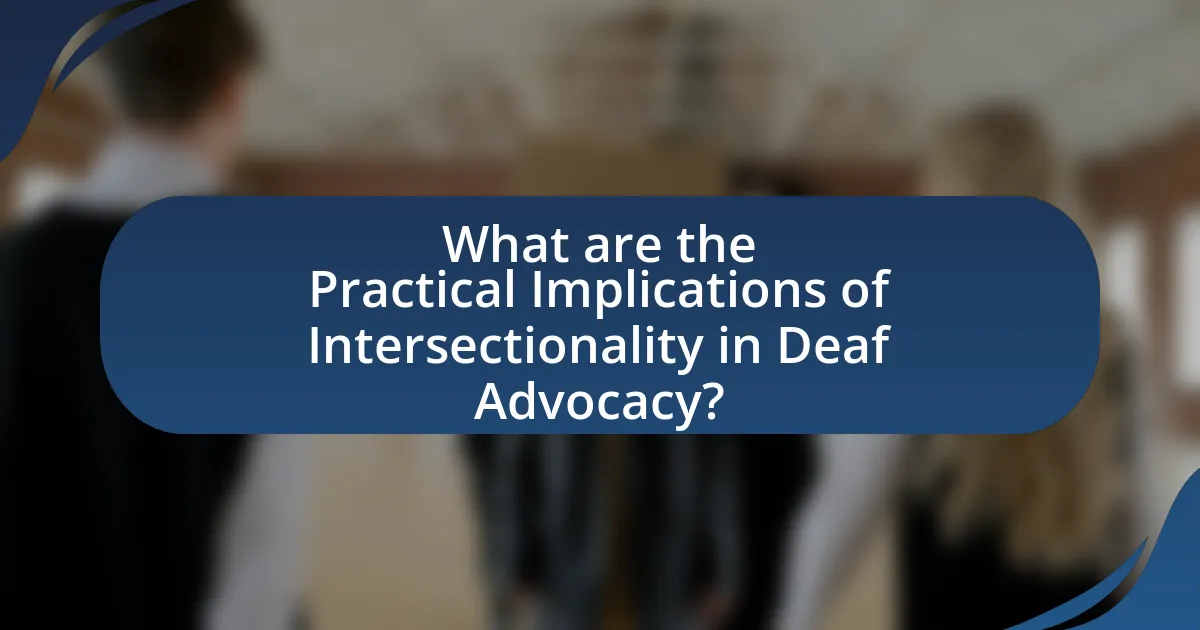
What are the Practical Implications of Intersectionality in Deaf Advocacy?
The practical implications of intersectionality in Deaf advocacy include the recognition and addressing of diverse identities and experiences within the Deaf community, which leads to more inclusive policies and practices. By understanding how factors such as race, gender, socioeconomic status, and disability intersect, advocates can tailor their approaches to meet the specific needs of marginalized groups within the Deaf population. For instance, research indicates that Deaf individuals from minority backgrounds often face compounded discrimination, which can hinder access to education and employment opportunities. This understanding drives advocacy efforts to create targeted resources and support systems that address these unique challenges, ultimately fostering a more equitable environment for all Deaf individuals.
How can intersectionality inform community engagement practices?
Intersectionality can inform community engagement practices by highlighting the diverse identities and experiences within marginalized groups, such as the Deaf community. This approach allows practitioners to recognize how overlapping social identities—like race, gender, and disability—impact individuals’ access to resources and participation in community activities. For instance, research by Crenshaw (1989) emphasizes that understanding these intersections can lead to more inclusive strategies that address specific barriers faced by individuals at the intersection of multiple identities. By applying intersectionality, community engagement initiatives can be tailored to meet the unique needs of various subgroups, ultimately fostering greater equity and participation.
What are best practices for inclusive advocacy in the Deaf community?
Best practices for inclusive advocacy in the Deaf community include actively involving Deaf individuals in decision-making processes, ensuring accessibility through sign language interpretation, and promoting awareness of diverse identities within the community. Engaging Deaf individuals in advocacy efforts fosters empowerment and ensures that their unique perspectives are represented. Accessibility is critical; studies show that effective communication access increases participation and engagement in advocacy initiatives. Additionally, recognizing intersectionality—such as the experiences of Deaf individuals who are also part of racial, gender, or LGBTQ+ minorities—enhances the inclusivity of advocacy efforts, as it addresses the varied challenges faced by different groups within the Deaf community.
How can advocates measure the impact of intersectional approaches?
Advocates can measure the impact of intersectional approaches by utilizing qualitative and quantitative research methods to assess outcomes across diverse identities. For instance, surveys and interviews can capture the experiences of individuals at the intersection of deafness and other identities, such as race or gender, providing insights into their unique challenges and successes. Additionally, analyzing demographic data alongside advocacy outcomes can reveal disparities and highlight areas for improvement. Research conducted by Crenshaw (1989) on intersectionality emphasizes the necessity of understanding how overlapping social identities affect individuals’ experiences, reinforcing the importance of these measurement strategies in advocacy efforts.
What resources are available for advocates to learn about intersectionality?
Advocates can learn about intersectionality through various resources, including academic literature, online courses, and community organizations. Notable academic texts such as “Intersectionality” by Kimberlé Crenshaw provide foundational knowledge on the subject. Online platforms like Coursera and edX offer courses specifically focused on intersectionality and social justice, enabling advocates to engage with the topic in a structured manner. Additionally, organizations such as the National LGBTQ Task Force and the Center for Intersectionality and Social Policy Studies provide workshops and materials that emphasize the importance of intersectionality in advocacy work. These resources collectively enhance understanding and application of intersectionality in various advocacy contexts, including Deaf advocacy.
Where can advocates find training on intersectional advocacy?
Advocates can find training on intersectional advocacy through organizations such as the National LGBTQ Task Force, which offers workshops and resources focused on intersectionality. Additionally, the Center for Intersectional Justice provides online courses and webinars that address the complexities of advocacy across different identities. These organizations are recognized for their commitment to educating advocates on the importance of considering multiple social identities in their work, thereby enhancing the effectiveness of advocacy efforts.
What literature is essential for understanding intersectionality in Deaf advocacy?
Essential literature for understanding intersectionality in Deaf advocacy includes “Deaf Gain: Raising the Stakes for Human Diversity” by H-Dirksen L. Bauman and Joseph J. Murray, which explores how Deaf culture intersects with various identities. Additionally, “Intersectionality” by Kimberlé Crenshaw provides foundational concepts that apply to multiple marginalized groups, including Deaf individuals. These texts highlight the complexities of identity and the necessity of considering multiple social categories, such as race, gender, and disability, in advocacy efforts. The integration of these perspectives is crucial for effective advocacy that addresses the unique challenges faced by Deaf individuals at the intersections of these identities.
